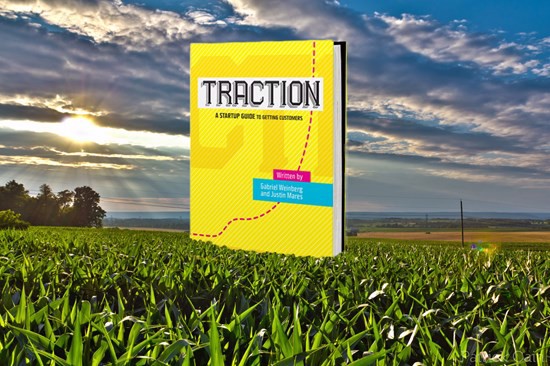Traction: If you build it they will come

Photo credit: photo (sans book) by Patrick Cain
Kevin Costner’s film ‘Field of Dreams’ is responsible for more startup failures than any other Holywood film ever created. In this film Ray Kinsella, a farmer played by Kevin Costner has a vision (AKA great idea), digs up his crop of corn and builds a baseball field in the middle of nowhere on the promise that ‘if he builds it, he will come’. Low and behold after some tense moments a famous dead baseball player turns up and eventually car loads of people turn up to watch baseball. So, it turns out, that if you build it, they will come. What the film fails to show (at least to my recollection), is the intensive marketing campaign that was required to get all those cars to turn up. I don’t think Kevin posted a single flyer, and he definitely didn’t have an email list or a signup webpage. A lot of startups seem to have been inspired by this film and the belief that a great idea and faith that they will come is all they need.
If you’ve learnt the lessons from The Lean Startup then you should in theory understand how to develop products in an experimental way. On the road to a great product you need to prove and disprove your assumptions with customers. What The Lean Startup fails to go into much detail about is how to get customers in the first place.
This gap has been filled by the new book Traction. In the Lean Startup Eric Ries shares his experience of using Google Adwords to get new potential customers to experiment on for his company IMVU’s chat client. This process is based on the big assumption that PPC adverts is a cost effective way of getting customers for your startup. This was true for IMVU at that time but as Andrew Chen’s law of shitty click throughs states ‘Over time, all marketing strategies result in shitty clickthrough rates’. So what worked well for IMVU in 2006 is unlikely to work well now. Google Adrates are much higher and therefore so is the customer acquisition cost through this channel.
The book Traction recommends an experimental approach early on to customer acquisition and gaining traction for your product. We should be splitting our time 50/50 between product development and traction development. Traction is harder than it seems and is always going to take longer than you hoped. So starting early and putting effort into your traction channels is little more than common sense. However, so many of us get so excited and drawn into product development that getting traction becomes the last thing we think of. Also, what works well now is going to change, so the effectiveness of your traction channels needs to be something you continually measure and are experimenting with.
What the book Traction does very well is provide a framework for finding effective ways to get traction for your business. It introduces 19 different traction channel types and interviews successful startup founders about things they’ve tried in those channels that worked for them.
The 19 channel types Traction describes are:
- Viral Marketing
- Public Relations (PR)
- Unconventional PR
- Search Engine Marketing (SEM)
- Social and Display Ads
- Offline Ads
- Search Engine Optimization (SEO)
- Content Marketing
- Email Marketing
- Engineering as Marketing
- Targeting Blogs
- Business Development
- Sales
- Affiliate Programs
- Existing Platforms
- Trade Shows
- Offline Events
- Speaking Engagements
- Community Building
No one’s attempt at categorising all possible traction channels is going to be perfect, but this is a great starting point for brainstorming traction ideas and a great way to get past staring at a blank page. The book also urges you not to discount channels without trying them. In fact if others in your industry have discounted a channel, this could offer you a massive advantage. You need to challenge and test any assumptions you have, just as you do with your product and customers.
The book doesn’t give you step by step instructions on exactly what to do to get traction for your business, but instead urges you to be creative, to experiment and measure new ideas to find what works for you. I think they could go into a lot more detail and share more examples for each channel. But perhaps the book serves better as a starting point for your own creative process and going into too more detail isn’t necessary to spark your imagination and inquisitiveness.
The Bullseye Framework they describe is also a good way to take your traction ideas and prove them on the road towards sustainable customer growth. I’d also recommend reading Lean Analytics to get a grip on exactly what stats you should be interested in when measuring the effectiveness of your business and your traction experiments.
I feel truly inspired by this book. I’ve known that gaining traction was a problem. I’ve had marketing ideas, but my previous approach has been a bit slapdash. The structure provided in this book has given me a lot of clarity, as has the way they describe the relationship between product development and traction development. Finding traction methods that will work for your business is still a creative process. This book doesn’t give you all the answers, but it gives you a good grounding to go and find ideas for yourself. Each chapter describing a channel left me hungry for more examples and ideas, but also sparked my imagination and made me keen to get brainstorming traction ideas for my next product. I can see myself turning to this book again and again.
If you’re interested, you can could download the first free chapters for free on their site at the moment.
